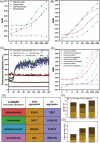Lecanemab preferentially binds to smaller aggregates present at early Alzheimer's disease
- PMID: 40237235
- PMCID: PMC12001052
- DOI: 10.1002/alz.70086
Lecanemab preferentially binds to smaller aggregates present at early Alzheimer's disease
Abstract
Introduction: The monoclonal antibodies Aducanumab, Lecanemab, Gantenerumab, and Donanemab were developed for the treatment of Alzheimer's disease (AD).
Methods: We used single-molecule detection and super-resolution imaging to characterize the binding of these antibodies to diffusible amyloid beta (Aβ) aggregates generated in-vitro and harvested from human brains.
Results: Lecanemab showed the best performance in terms of binding to the small-diffusible Aβ aggregates, affinity, aggregate coating, and the ability to bind to post-translationally modified species, providing an explanation for its therapeutic success. We observed a Braak stage-dependent increase in small-diffusible aggregate quantity and size, which was detectable with Aducanumab and Gantenerumab, but not Lecanemab, showing that the diffusible Aβ aggregates change with disease progression and the smaller aggregates to which Lecanemab preferably binds exist at higher quantities during earlier stages.
Discussion: These findings provide an explanation for the success of Lecanemab in clinical trials and suggests that Lecanemab will be more effective when used in early-stage AD.
Highlights: Anti amyloid beta therapeutics are compared by their diffusible aggregate binding characteristics. In-vitro and brain-derived aggregates are tested using single-molecule detection. Lecanemab shows therapeutic success by binding to aggregates formed in early disease. Lecanemab binds to these aggregates with high affinity and coats them better.
Keywords: Alzheimer's disease; amyloid beta; diffusible aggregate; monoclonal antibody; single‐molecule detection; super‐resolution microscopy; therapeutic success.
© 2025 The Author(s). Alzheimer's & Dementia published by Wiley Periodicals LLC on behalf of Alzheimer's Association.
Conflict of interest statement
B.D.S. has been a consultant for Eli Lilly, Biogen, Janssen Pharmaceutica, Eisai, and AbbVie and other companies, but not on their antibody programs. He is consultant to Muna Therapeutics. B.D.S. is a scientific founder of Augustine Therapeutics and a scientific founder and stockholder of Muna Therapeutics. Author disclosures are available in the Supporting Information.
Figures



Similar articles
-
Lecanemab, Aducanumab, and Gantenerumab - Binding Profiles to Different Forms of Amyloid-Beta Might Explain Efficacy and Side Effects in Clinical Trials for Alzheimer's Disease.Neurotherapeutics. 2023 Jan;20(1):195-206. doi: 10.1007/s13311-022-01308-6. Epub 2022 Oct 17. Neurotherapeutics. 2023. PMID: 36253511 Free PMC article.
-
Second-generation anti-amyloid monoclonal antibodies for Alzheimer's disease: current landscape and future perspectives.Transl Neurodegener. 2025 Jan 27;14(1):6. doi: 10.1186/s40035-025-00465-w. Transl Neurodegener. 2025. PMID: 39865265 Free PMC article. Review.
-
Lecanemab Binds to Transgenic Mouse Model-Derived Amyloid-β Fibril Structures Resembling Alzheimer's Disease Type I, Type II and Arctic Folds.Neuropathol Appl Neurobiol. 2025 Jun;51(3):e70022. doi: 10.1111/nan.70022. Neuropathol Appl Neurobiol. 2025. PMID: 40495448 Free PMC article.
-
Lecanemab demonstrates highly selective binding to Aβ protofibrils isolated from Alzheimer's disease brains.Mol Cell Neurosci. 2024 Sep;130:103949. doi: 10.1016/j.mcn.2024.103949. Epub 2024 Jun 20. Mol Cell Neurosci. 2024. PMID: 38906341
-
What's in It for Me? Contextualizing the Potential Clinical Impacts of Lecanemab, Donanemab, and Other Anti-β-amyloid Monoclonal Antibodies in Early Alzheimer's Disease.eNeuro. 2024 Sep 27;11(9):ENEURO.0088-24.2024. doi: 10.1523/ENEURO.0088-24.2024. Print 2024 Sep. eNeuro. 2024. PMID: 39332901 Free PMC article. Review.
Cited by
-
An integrated view of the relationships between amyloid, tau, and inflammatory pathophysiology in Alzheimer's disease.Alzheimers Dement. 2025 Aug;21(8):e70404. doi: 10.1002/alz.70404. Alzheimers Dement. 2025. PMID: 40767321 Free PMC article. Review.
-
Brain-derived extracellular vesicle microRNAs in Lewy body and Alzheimer's disease.bioRxiv [Preprint]. 2025 Jun 9:2025.06.06.656900. doi: 10.1101/2025.06.06.656900. bioRxiv. 2025. PMID: 40661348 Free PMC article. Preprint.
-
Chimeric antigen receptors discriminate between tau and distinct amyloid-beta species.J Transl Med. 2025 May 30;23(1):605. doi: 10.1186/s12967-025-06572-6. J Transl Med. 2025. PMID: 40448101 Free PMC article.
-
Small-diffusible aggregates, plaques, tangles, and dynamic equilibria: Untangling Alzheimer's disease.Alzheimers Dement. 2025 Jul;21(7):e70462. doi: 10.1002/alz.70462. Alzheimers Dement. 2025. PMID: 40611371 Free PMC article. Review.
References
MeSH terms
Substances
Grants and funding
LinkOut - more resources
Full Text Sources
Medical

